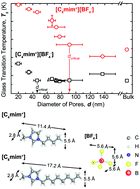The effect of nanoconfinement on the glass transition temperature of ionic liquids†
Abstract
This work is concerned with investigating the glass transition behavior of ionic liquids as a function of nanoconfinement. The glass transition temperature was found to increase with a decrease in confinement length, below a critical confinement of 40–50 nm and 80–90 nm for 1-butyl-3-methylimidazolium tetrafluoro-borate and 1-methyl-3-octylimidazolium tetrafluoro-borate between alumina surfaces, respectively.



 Please wait while we load your content...
Please wait while we load your content...
